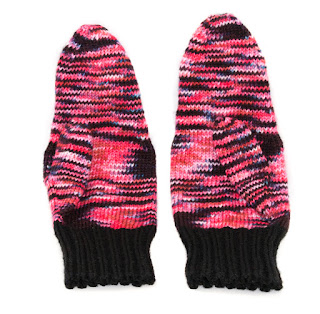So you may have noticed that this is not one of my "How To" posts, and that the title has the word "Trying" in it...
To quote
DyeYourYarn.com, "...if you want a hank of
solid black wool - just go ahead and
buy one. It is very difficult to dye large amounts of yarn a true black."
And there is a very good reason for this, if you are dyeing with food safe colours. It is because there is no such thing as a true black food colouring. Black food colouring is actually a blend of a lot of other colours, and has a tendency to lean more towards one colour or the other. In the blacks I have worked with, the colours tend to be either more green or more red than I had anticipated.
Part of this has to do with the way the dyes strike on the yarn. As I think I have mentioned in a previous post, reds will strike faster than blues, which can mean you get more of a reddish tinge to the yarn. And black has a tendency to "break" when you use it to dye yarn, meaning the various colours not only strike a different times, but tend to actually separate on the yarn. This is a great effect if that is what you are going for, but can be a pain in the butt if you are trying for a solid colour.
I have used black a few times in the past as an accent colour. The first time I used it was in combination with some pink. It did give me a dark colour, which looks nice next to the pink, but it is a bit lighter than a black in person, and in one or two spots, looks a bit closer to an extremely dark brown. I don't remember what I used for this one, as this was back when I was not taking very good notes. I THINK this was the new "non-breaking" black from Wilton's. Their old formula broke really easily, while the new one seems to hold together a bit better.
 |
| Pretty in Punk |
This yarn went on to become a pair of socks and a pair of mittens.
 |
| Pinky Socks |
 |
| Punky Mittens |
I have also dyed black using the Wilton Color Right system black. Both times it was done on sections of the yarn, not the full skein
 |
| Bigger section of the yarn dyed black. You can see that it has a reddish tinge to it, and can see a few spots where the dye did not really strike, and there are light almost blue sections |
 |
| That yarn above resulted in this sock. Looks like black stripes to me. As long as you don't look too close |
 |
| For this one, I just painted black sections. The black was thickened with guar gum to keep it in place, but you can still see where it bled into the other colours once they were added. Mostly because they were just water, and I was not doing it over a cooling rack, so the water pooled up and caused the black to run |
 |
| A swatch of the yarn above. I have not knit up socks with it yet. |
Today I am going to try to dye a whole skein, and see how close to black I can get it. I am using 100g of my bare Opal sock yarn, and am going to try the Americolor Super Black. Even though I know this colour contains Red #3, which can be problematic, I have read that some people have had more luck with that one that with any of the Wilton colours.
I will post again either later today or tomorrow with the results from my full skein of black!







I love your dye results and sharing, thanks a lot.
ReplyDelete